Biographies are unsung heroes in the reading lives of children. Well-written biographies can provide memorable and pleasurable experiences as much as they can insight into the lives of the people depicted. The books reviewed in this column will engage children in thinking about how these life stories contribute to their knowledge of events and other times and places.
Ages 4–8
Balderdash! John Newbery and the Boisterous Birth of Children’s Books. Michelle Markel. Ill. Nancy Carpenter. 2017. Chronicle.
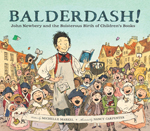 The first page of Balderdash! welcomes readers with the statement, “Lucky, lucky reader. Be glad it’s not 1726.” Why? Because at that time children had to read “preachy poems and fables” and “the future champion of children’s books was just a lad.” That lad was John Newbery, who loved books and went on to become a publisher and London bookseller. Newbery believed that reading should be a treat for children, and his first book for children, A Little Pretty Pocket-Book, was just that. Newbery’s success in publishing delightful books for children led other publishers to produce children’s books and earned him the title of “Father of Children’s Literature.” Nancy Carpenter’s illustrations, rendered in pen and ink and digital media, are filled with details that set the scene and match the wit of Michelle Merkel’s text. An end note provides more information about John Newbery (1713–1767) and the books mentioned in Balderdash! and lists resources.
The first page of Balderdash! welcomes readers with the statement, “Lucky, lucky reader. Be glad it’s not 1726.” Why? Because at that time children had to read “preachy poems and fables” and “the future champion of children’s books was just a lad.” That lad was John Newbery, who loved books and went on to become a publisher and London bookseller. Newbery believed that reading should be a treat for children, and his first book for children, A Little Pretty Pocket-Book, was just that. Newbery’s success in publishing delightful books for children led other publishers to produce children’s books and earned him the title of “Father of Children’s Literature.” Nancy Carpenter’s illustrations, rendered in pen and ink and digital media, are filled with details that set the scene and match the wit of Michelle Merkel’s text. An end note provides more information about John Newbery (1713–1767) and the books mentioned in Balderdash! and lists resources.
—CA
Fancy Party Gowns: The Story of Ann Cole Lowe. Deborah Blumenthal. Ill. Laura Freeman. 2017. Little Bee.
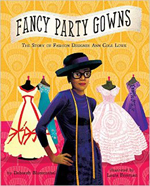 Throughout her life, Ann Cole Lowe (1898–1981) “thought about what she could, not what she couldn’t change.” She used her energy, creativity, and resourcefulness to create beautiful gowns. Her great-grandmother had been a slave, her mother became a dress maker for fashionable women, and, from an early age, Ann loved using scraps of fabric in her mother’s shop to make beautiful flowers. Later, she fulfilled the orders for gowns left by her deceased mother and began her own career as a fashion designer in New York City. Although she faced discrimination, she learned that doing what one loves sets the spirit soaring. Ann continued to make beautiful gowns (including the wedding gown for Jacqueline Bouvier Kennedy) and became a celebrated couturière. Drawings of gowns on the end sheets add interest, and the author’s note provides additional biographical detail.
Throughout her life, Ann Cole Lowe (1898–1981) “thought about what she could, not what she couldn’t change.” She used her energy, creativity, and resourcefulness to create beautiful gowns. Her great-grandmother had been a slave, her mother became a dress maker for fashionable women, and, from an early age, Ann loved using scraps of fabric in her mother’s shop to make beautiful flowers. Later, she fulfilled the orders for gowns left by her deceased mother and began her own career as a fashion designer in New York City. Although she faced discrimination, she learned that doing what one loves sets the spirit soaring. Ann continued to make beautiful gowns (including the wedding gown for Jacqueline Bouvier Kennedy) and became a celebrated couturière. Drawings of gowns on the end sheets add interest, and the author’s note provides additional biographical detail.
—SW
Waiting for Pumpsie. Barry Wittenstein. Ill. London Ladd. 2017. Charlesbridge.
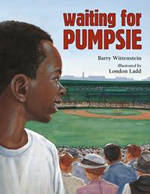 In Boston in 1959, young Bernard, the fictional narrator of the story and an avid baseball fan, wanted Elijah “Pumpsie” Green (b. 1933), a minor-league shortstop, to be the first black player for the Red Sox. Jackie Robinson had been retired already, yet Pumpsie was kept out of the game. The story is as much about the times in which Bernard lived, with the people’s growing sense of civil rights and integration, as it is about Pumpsie. The illustrations, rendered in acrylic paint with colored pencil, capture the excitement of the games and the expressions of Bernard and his family as they cheer for the team. After the game in which Pumpsie finally plays and the Red Sox becomes the last team in the Major Leagues to integrate, Bernard says, “One day I’ll tell my kids how long we waited for Pumpsie Green.” The back matter includes an author’s note and sources.
In Boston in 1959, young Bernard, the fictional narrator of the story and an avid baseball fan, wanted Elijah “Pumpsie” Green (b. 1933), a minor-league shortstop, to be the first black player for the Red Sox. Jackie Robinson had been retired already, yet Pumpsie was kept out of the game. The story is as much about the times in which Bernard lived, with the people’s growing sense of civil rights and integration, as it is about Pumpsie. The illustrations, rendered in acrylic paint with colored pencil, capture the excitement of the games and the expressions of Bernard and his family as they cheer for the team. After the game in which Pumpsie finally plays and the Red Sox becomes the last team in the Major Leagues to integrate, Bernard says, “One day I’ll tell my kids how long we waited for Pumpsie Green.” The back matter includes an author’s note and sources.
—SW
Ages 9–11
Frederick Douglass: The Lion Who Wrote History. Walter Dean Myers. Ill. Floyd Cooper. 2017. Harper/HarperCollins.
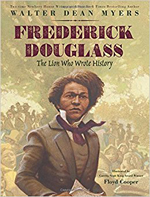 Walter Dean Myers centers this eloquent tribute to Frederick Douglass (1818–1895) around major life decisions Douglass made: teaching himself to read, escaping to freedom and taking refuge with abolitionists in New York City, becoming a voice for the anti-slavery movement and the rights of black people and women, and urging black men to enlist in the Union Army during the Civil War. These decisions shaped Frederick Douglass’s life and the history of the United States. Floyd Cooper’s illustrations are dramatic portraits of this important figure in American history, who’s voice, “born in the soft tones of the slave population, truly became a lion’s roar.” Back matter includes a timeline and a bibliography.
Walter Dean Myers centers this eloquent tribute to Frederick Douglass (1818–1895) around major life decisions Douglass made: teaching himself to read, escaping to freedom and taking refuge with abolitionists in New York City, becoming a voice for the anti-slavery movement and the rights of black people and women, and urging black men to enlist in the Union Army during the Civil War. These decisions shaped Frederick Douglass’s life and the history of the United States. Floyd Cooper’s illustrations are dramatic portraits of this important figure in American history, who’s voice, “born in the soft tones of the slave population, truly became a lion’s roar.” Back matter includes a timeline and a bibliography.
—CA
Noah Webster’s Fighting Words. Tracy Nelson Maurer. Ill. Mircea Catusanu. 2017. Millbrook/Lerner.
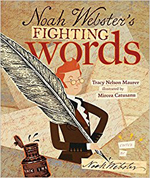 In this cleverly designed book, Noah Webster (1758–1843) takes up a red pencil and edits Maurer’s story of his life and work. A staunch patriot, Webster had strong opinions about everything. He believed that a complete break from Great Britain should include the way in which Americans spoke and spelled words in the English language. Believing that change needed to start with school children, he wrote a speller in which words were spelled the way they sounded. He also insisted that a dictionary must change as people changed the way they used language. His An American Dictionary of the English Language was published in 1828. Collage-style illustrations with excerpts of books, newspapers, and Webster’s letters and humorously detailed mixed-media cartoonlike images enhance the lively text of this biography of Noah Webster. Back matter includes author’s and illustrator’s notes, a timeline, sources of quotes, a selected bibliography, primary sources, and websites.
In this cleverly designed book, Noah Webster (1758–1843) takes up a red pencil and edits Maurer’s story of his life and work. A staunch patriot, Webster had strong opinions about everything. He believed that a complete break from Great Britain should include the way in which Americans spoke and spelled words in the English language. Believing that change needed to start with school children, he wrote a speller in which words were spelled the way they sounded. He also insisted that a dictionary must change as people changed the way they used language. His An American Dictionary of the English Language was published in 1828. Collage-style illustrations with excerpts of books, newspapers, and Webster’s letters and humorously detailed mixed-media cartoonlike images enhance the lively text of this biography of Noah Webster. Back matter includes author’s and illustrator’s notes, a timeline, sources of quotes, a selected bibliography, primary sources, and websites.
—CA
The Youngest Marcher: The Story of Audrey Faye Hendricks, a Young Civil Rights Activist. Cynthia Levinson. Ill. Vanessa Brantley Newton. 2017. Atheneum/Simon & Schuster.
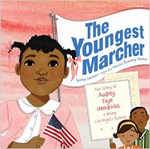 Nine-year-old Audrey Faye Hendricks (1952–2009) was accustomed to having Sunday dinner with the Reverend Martin Luther King, Jr., Fred Shuttlesworth, and Jim Bevel as well as attended the meetings with Reverend King at Sixteenth Baptist Church in Birmingham. It was 1963, and she wondered what she could do against injustice and inequality. When Reverend King asked who would be willing to go to jail in a civil rights protest march, Audrey had her chance to do something. What she didn’t know about were the harsh conditions of being in jail. The illustrations, rendered in digital collage, recount the Children’s Crusade March, which filled the town’s jails with arrested marchers, and Audrey’s week in jail. The back matter includes sources, a timeline, and an interview with Audrey Faye Hendricks, whose involvement as a civil rights activist is also part of Levinson’s (2012) We’ve Got a Job: The 1963 Birmingham Children’s March, a longer nonfiction book.
Nine-year-old Audrey Faye Hendricks (1952–2009) was accustomed to having Sunday dinner with the Reverend Martin Luther King, Jr., Fred Shuttlesworth, and Jim Bevel as well as attended the meetings with Reverend King at Sixteenth Baptist Church in Birmingham. It was 1963, and she wondered what she could do against injustice and inequality. When Reverend King asked who would be willing to go to jail in a civil rights protest march, Audrey had her chance to do something. What she didn’t know about were the harsh conditions of being in jail. The illustrations, rendered in digital collage, recount the Children’s Crusade March, which filled the town’s jails with arrested marchers, and Audrey’s week in jail. The back matter includes sources, a timeline, and an interview with Audrey Faye Hendricks, whose involvement as a civil rights activist is also part of Levinson’s (2012) We’ve Got a Job: The 1963 Birmingham Children’s March, a longer nonfiction book.
—SW
Ages 12–14
Higher, Steeper, Faster: The Daredevils Who Conquered the Skies. Lawrence Goldstone.2017. Little, Brown.
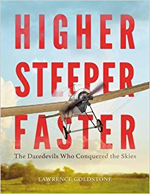 Aviation history of the beginning of the twentieth century often features Orville (1871–1948) and Wilbur Wright (1867–1912) and their Flyer at Kitty Hawk, but this book highlights the life of aviator Lincoln Beachey and tells the stories of men and women, who, in their passion for flying, experimented with aircraft. They flew airplanes in daring high stakes competitions in what Goldstone calls the exhibition era, testing the aerodynamics, speed, and power of aircraft, and engaging growing numbers of spectators, on both sides of the Atlantic, fascinated by what the airplane could do. By 1915 airplanes routinely flew “one hundred miles without refueling, attaining altitudes of more than twelve thousand feet, and reaching speeds greater than one hundred miles per hour.” Archival photographs of pilots, improvements to the airplane, and inventors, memorable moments of aerial daring, and entrepreneurs who financed the competitions illustrate the drama and purpose that drove invention and inspired pilots and airplane developers, including the Wright brothers. Back matter includes a timeline, glossary, source notes, a bibliography, and an index.
Aviation history of the beginning of the twentieth century often features Orville (1871–1948) and Wilbur Wright (1867–1912) and their Flyer at Kitty Hawk, but this book highlights the life of aviator Lincoln Beachey and tells the stories of men and women, who, in their passion for flying, experimented with aircraft. They flew airplanes in daring high stakes competitions in what Goldstone calls the exhibition era, testing the aerodynamics, speed, and power of aircraft, and engaging growing numbers of spectators, on both sides of the Atlantic, fascinated by what the airplane could do. By 1915 airplanes routinely flew “one hundred miles without refueling, attaining altitudes of more than twelve thousand feet, and reaching speeds greater than one hundred miles per hour.” Archival photographs of pilots, improvements to the airplane, and inventors, memorable moments of aerial daring, and entrepreneurs who financed the competitions illustrate the drama and purpose that drove invention and inspired pilots and airplane developers, including the Wright brothers. Back matter includes a timeline, glossary, source notes, a bibliography, and an index.
—SW
Isaac the Alchemist: Secrets of Isaac Newton, Reveal’d. Mary Losure. 2017. Candlewick.
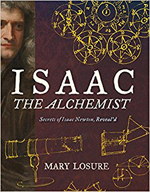 Isaac Newton (1642–1727) was a curious child and a loner, “living at a time when no one knew where magic ended and science began.” Isaac was intrigued by the writings of alchemists, who were searching for the miraculous philosopher’s stone. The largely self-taught Newton kept notebooks on his questions, observations, and experiments. His discoveries in mathematics and science, once kept secretively in his notebooks, became the foundation of physics. In the prologue Mary Losure affirms, “He would become the world’s greatest alchemist. He would also (by following his own odd and lonely path) become one of the greatest scientists who ever lived.” Illustrated with engravings and pages from Newton’s notebooks and published works, Losure’s narrative account of Isaac Newton’s life and work supports these statements in an accessible and engaging fashion. Back matter includes an author’s note, source notes, a bibliography, and an index.
Isaac Newton (1642–1727) was a curious child and a loner, “living at a time when no one knew where magic ended and science began.” Isaac was intrigued by the writings of alchemists, who were searching for the miraculous philosopher’s stone. The largely self-taught Newton kept notebooks on his questions, observations, and experiments. His discoveries in mathematics and science, once kept secretively in his notebooks, became the foundation of physics. In the prologue Mary Losure affirms, “He would become the world’s greatest alchemist. He would also (by following his own odd and lonely path) become one of the greatest scientists who ever lived.” Illustrated with engravings and pages from Newton’s notebooks and published works, Losure’s narrative account of Isaac Newton’s life and work supports these statements in an accessible and engaging fashion. Back matter includes an author’s note, source notes, a bibliography, and an index.
—CA
Ages 15+
Alice Paul and the Fight for Women’s Rights. Deborah Kops. 2017. Calkins Creek/Highlights.
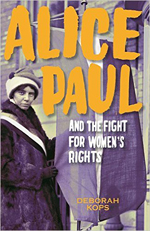 Deborah Kops introduces readers to Alice Paul (1885–1977) in a well-researched biography that celebrates not only her life dedicated to the fight for women’s rights but also U.S. women’s history. Alice Paul was a tireless organizer of rallies and protest marches as leader of the National American Woman Suffrage Association and later of the National Woman’s Party. Picketing of the White House in support of the federal suffrage amendment resulted in numerous arrests and incarcerations for Paul and other suffragists. Paul’s fight for women’s rights did not end with the ratification of the Nineteenth Amendment. She went on to write the Equal Right Amendment, which would have made all laws discriminating against women unconstitutional, and tirelessly worked for its passage in Congress and in support of its ratification until her death. The engaging narrative, with numerous quotes from Paul’s letters and journals, is enriched by a wealth of captioned archival photographs. Back matter includes a “Who Is Who” section, an author’s note, source notes, a bibliography, and index. This is an important and inspiring book for today.
Deborah Kops introduces readers to Alice Paul (1885–1977) in a well-researched biography that celebrates not only her life dedicated to the fight for women’s rights but also U.S. women’s history. Alice Paul was a tireless organizer of rallies and protest marches as leader of the National American Woman Suffrage Association and later of the National Woman’s Party. Picketing of the White House in support of the federal suffrage amendment resulted in numerous arrests and incarcerations for Paul and other suffragists. Paul’s fight for women’s rights did not end with the ratification of the Nineteenth Amendment. She went on to write the Equal Right Amendment, which would have made all laws discriminating against women unconstitutional, and tirelessly worked for its passage in Congress and in support of its ratification until her death. The engaging narrative, with numerous quotes from Paul’s letters and journals, is enriched by a wealth of captioned archival photographs. Back matter includes a “Who Is Who” section, an author’s note, source notes, a bibliography, and index. This is an important and inspiring book for today.
—CA
Sandip Wilson serves as associate professor in the College of Health and Education of Husson University in Bangor, ME. Carolyn Angus is former Director of the George G. Stone Center for Children's Books, Claremont Graduate University, Claremont, CA.
These reviews are submitted by members of the International Literacy Association's Children's Literature and Reading Special Interest Group (CL/R SIG) and are published weekly on Literacy Daily.